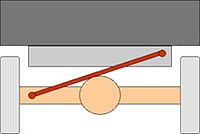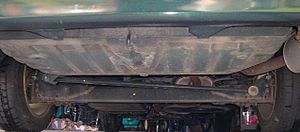Panhard rod
A Panhard rod or track bar is a component of a car suspension system that provides lateral location of the axle. Originally invented by the Panhard automobile company of France in the early twentieth century, this device has been widely used ever since.
While the purpose of the rear suspension of an automobile is to allow the wheels to move vertically with respect to the body, it is undesirable to allow them to move forward and backwards, or from side to side. It is this latter movement that the Panhard rod is designed to prevent. It is a simple device, consisting of a rigid bar running sideways parallel to the rear axle, connecting one end of the axle to the car body or chassis on the opposite side of the vehicle. The bar is attached on either end with pivots that permit it to swivel upwards and downwards only, so that the axle is in turn allowed to move in the vertical plane only. This does not effectively locate the axle longitudinally, therefore it is usually used in conjunction with trailing arms which locate the axle in the longitudinal direction. This arrangement is not usually used with a leaf spring rear suspension, where the springs themselves supply enough lateral rigidity, but only with coil spring suspensions.
The advantage of the Panhard rod is its simplicity. Its major disadvantage is that the axle must necessarily move in an arc, relative to the body, with the radius equal to the length of the Panhard rod. If the rod is too short, there will be excessive sideways movement between the axle and the body at the ends of the spring travel; therefore the Panhard rod is less desirable on smaller cars than larger. A suspension design that is similar but eliminates the sideways component of the axle's vertical travel is Watt's linkage.

